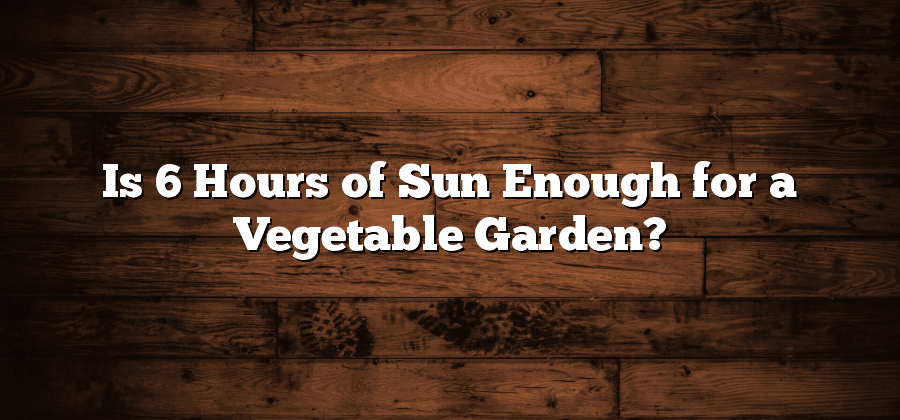Optimal Sunlight Duration for Vegetable Gardens
When it comes to the optimal sunlight duration for vegetable gardens, it is important to strike the right balance. While sunlight is essential for the growth of vegetables, too much or too little can have negative effects. Generally, most vegetable plants thrive with about 6-8 hours of direct sunlight per day. This allows them to undergo photosynthesis, a process that converts sunlight into energy, enabling plants to grow and produce food. However, different vegetables have varying sunlight requirements, and factors such as geography, season, and climate should also be taken into consideration when determining the optimal sunlight duration for a vegetable garden.
It is worth noting that some vegetables, such as leafy greens, root crops, and herbs, can tolerate slightly less sunlight than other varieties. These plants tend to perform well with around 4-6 hours of direct sunlight per day. On the other hand, vegetables like tomatoes, peppers, and cucumbers, which require a higher amount of energy to produce fruits, benefit from at least 6-8 hours of direct sunlight. It is essential to choose the right location for your vegetable garden, considering factors such as the presence of shade from buildings or trees that may obstruct sunlight, as well as potential microclimates within your yard that may affect light exposure.
Factors to Consider for Vegetable Garden Sunlight
When planning your vegetable garden, one of the main factors to consider is the amount of sunlight your plants will receive. Sunlight is crucial for the growth and overall health of your vegetables. Before you start planting, it’s essential to evaluate the sunlight patterns in your garden.
The first factor to consider is the duration of sunlight. Most vegetables require at least six to eight hours of direct sunlight each day to thrive. However, it’s important to note that some plants, such as leafy greens, can tolerate more shade and require slightly less sunlight. On the other hand, fruiting vegetables like tomatoes and peppers often need the full eight hours or more to produce a bountiful harvest. Assessing the amount of sunlight your garden receives throughout the day will help you determine which vegetables are best suited for each area and optimize their growth.
Ideal Sun Exposure for Different Vegetable Types
Different vegetable types have varying requirements when it comes to sun exposure in order to thrive and produce abundant yields. Some vegetables, like tomatoes and peppers, favor direct sunlight and require at least 6-8 hours of uninterrupted exposure each day. These sun-loving vegetables rely on the sun’s rays to convert energy through photosynthesis, which in turn fuels growth and fruit production.
On the other hand, leafy greens such as lettuce and spinach can tolerate less direct sunlight and thrive in partially shaded areas. These vegetables benefit from receiving around 4-6 hours of sunlight per day, as it helps stimulate leaf growth and maintains their vibrant green color. While they can handle some shade, it is important to ensure they still receive enough sun exposure to meet their basic energy needs.
Understanding the ideal sun exposure requirements for different vegetable types is crucial for planning and maintaining a successful garden. By taking into account these specific needs, gardeners can optimize growth and maximize the potential of their vegetable plants.
The Importance of Sunlight for Vegetable Growth
Sunlight plays a crucial role in the growth and development of vegetable plants. It provides the energy needed for photosynthesis, the process by which plants convert sunlight into food. This food, in the form of carbohydrates, is essential for the plants to carry out their various metabolic functions, such as growth, reproduction, and defense against diseases and pests. In addition, sunlight helps regulate the plants’ circadian rhythm, ensuring they function optimally throughout the day.
Without sufficient sunlight, vegetable plants may become weak and leggy, with elongated stems and pale leaves. This phenomenon, known as etiolation, occurs as the plants stretch towards the nearest light source in an attempt to gather as much energy as possible. However, the lack of adequate sunlight results in decreased chlorophyll production, reducing the plants’ ability to carry out photosynthesis efficiently. The overall effect is stunted growth and poor yield. Therefore, it is essential to provide vegetable gardens with an optimal amount of sunlight to ensure healthy plant growth and a bountiful harvest.
Effects of Insufficient Sunlight on Vegetable Gardens
Insufficient sunlight can have detrimental effects on the growth and health of vegetable gardens. Without an adequate amount of sunlight, vegetables may fail to reach their full potential, leading to stunted growth and a decrease in overall yield. This is because sunlight is essential for the process of photosynthesis, which allows plants to convert light energy into chemical energy and produce the sugars they need for growth and development.
When a vegetable garden does not receive enough sunlight, the plants may become weak and leggy, with thinner stems and smaller leaves. The lack of direct sunlight can also cause the plants to stretch towards the available light source, resulting in a taller and more brittle plant. Moreover, insufficient exposure to sunlight can disrupt the balance of nutrients and hormones within the plants, leading to nutrient deficiencies and a decreased ability to resist pests and diseases. As a result, the overall vitality and productivity of the vegetable garden may be significantly compromised.






